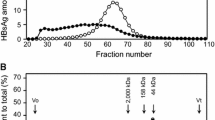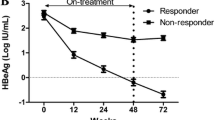Abstract
Two commercial quantitative immunoassay platforms are currently available for the detection of hepatitis B surface antigen (HBsAg) within a wide range of concentrations: the Architect HBsAg assay and the Elecsys HBsAg II. However, there are limited data concerning their performance in patients who are positive for both HBsAg and anti-HBs antibodies. In the present study, 127 serum samples from Chinese patients with hepatitis B carrying both HBsAg and anti-HBs antibodies were analyzed. HBsAg levels measured in parallel using the Elecsys HBsAg II and Architect HBsAg assay were compared. There was a significant correlation between HBsAg levels measured by Elecsys HBsAg II and Architect HBsAg assay (correlation coefficient, r = 0.992, P < 0.05). Bland-Altman analysis indicated only minor discordance between the methods (mean difference between Elecsys HBsAg II and Architect HBsAg assay, −0.02 log10 IU/ml; 95 % confidence interval, −0.40–0.37 log10 IU/ml). In conclusion, the results of the quantitative Elecsys HBsAg II were highly correlated with those of the Architect HBsAg assay in patients carrying both HBsAg and anti-HBs antibodies, but differences were observed between the platforms in samples with low HBsAg levels.




Similar content being viewed by others
References
Li MR, Xi HL, Wang QH, Hou FQ, Huo N, Zhang XX, Li F, Xu XY (2014) Kinetics and prediction of HBsAg loss during long-term therapy with nucleos(t)ide analogues of different potency in patients with chronic hepatitis B. PLoS ONE 9(6):e98476
Ke W, Liu L, Zhang C, Ye X, Gao Y, Zhou S, Yang Y (2014) Comparison of efficacy and safety of tenofovir and entecavir in chronic hepatitis B virus infection: a systematic review and meta-analysis. PLoS ONE 9(6):e98865
Dienstag JL (2008) Hepatitis B virus infection. N Engl J Med 359:1486–1500
Wursthorn K, Lutgehetmann M, Dandri M (2006) Peginterferon alpha-2b plus adefovir induce strong cccDNA decline and HBsAg reduction in patients with chronic hepatitis B. Hepatology 44:675–684
Yang R, Cong X, Xu Z, Xu D, Huang W, Maertens R, Wei L (2010) INNO-LiPA HBV genotyping is highly consistent with direct sequencing and sensitive in detecting B/C mixed genotype infection in Chinese chronic hepatitis B patients and asymptomatic HBV carriers. Clin Chim Acta 411:1951–1956
Yao JL (1996) Perinatal transmission of hepatitis B virus infection and vaccination in China. Gut 38(Suppl 2):S37–S38
Liang X, Bi S, Yang W, Wang L, Cui G, Cui F, Zhang Y, Liu J, Gong X, Chen Y, Wang F, Zheng H, Wang F, Guo J, Jia Z, Ma J, Wang H, Luo H, Li L, Jin S, Hadler SC, Wang Y (2009) Epidemiological serosurvey of hepatitis B in China–declining HBV prevalence due to hepatitis B vaccination. Vaccine 27:6550–6557
Zhang YM, Yang YD, Jia HY, Zeng LY, Yu W, Zhou N, Li LJ (2014) HBsAg levels in HBeAg-positive chronic hepatitis B patients with different immune conditions. World J Gastroenterol 20(15):4407–4413
European Association for the Study of the Liver (2009) EASL clinical practice guidelines: management of chronic hepatitis B. J Hepatol 50:227–242
Bowden S (2006) Serological and molecular diagnosis. Semin Liver Dis 26:97–103
Hatzakis A, Magiorkinis E, Haida C (2006) HBV virological assessment. J Hepatol 44(1 Suppl):S71–S76
Thompson AJ, Nguyen T, Iser D, Ayres A, Jackson K, Littlejohn M (2010) Serum hepatitis B surface antigen and hepatitis B e antigen titers: disease phase influences correlation with viral load and intrahepatic hepatitis B virus markers. Hepatology 51:1933–1944
Moucari R, Marcellin P (2011) Quantification of hepatitis B surface antigen: a new concept for the management of chronic hepatitis B. Liver Int 31:122–128
Werle-Lapostolle B, Bowden S, Locarnini S (2004) Persistence of cccDNA during the natural history of chronic hepatitis B and decline during adefovir dipivoxil therapy. Gastroenterology 126:1750–1758
Marcellin P, Asselah T, Boyer N (2005) Treatment of chronic hepatitis B. J Viral Hepat 12:333–335
Chu CM, Liaw YF (2006) Hepatitis B virus-related cirrhosis: natural history and treatment. Semin Liver Dis 26:142–152
Moucari R, Mackiewicz V, Lada O (2009) Early serum HBsAg drop: a strong predictor of sustained virological response to pegylated interferon alfa-2a in HBeAg-negative patients. Hepatology 49:1151–1157
Brunetto MR, Moriconi F, Bonino F (2009) Hepatitis B virus surface antigen levels: a guide to sustained response to peginterferon alfa-2a in HBeAg-negative chronic hepatitis B. Hepatology 49:1141–1150
Chan HL, Wong VW, Tse AM (2007) Serum hepatitis B surface antigen quantitation can reflect hepatitis B virus in the liver and predict treatment response. Clin Gastroenterol Hepatol 5:1462–1468
Chan HL, Wong VW, Chim AM, Chan HY, Wong GL, Sung JJ (2010) Serum HBsAg quantification to predict response to peginterferon therapy of e antigen positive chronic hepatitis B. Aliment Pharmacol Ther 32:1323–1331
Deguchi M, Yamashita N, Kagita M (2004) Quantitation of hepatitis B surface antigen by an automated chemiluminescent microparticle immunoassay. J Virol Methods 115:217–222
Kohno H, Inoue T, Tsuda F, Okamoto H, Akahane Y (1996) Mutations in the envelope gene of hepatitis B virus variants co-occurring with antibody to surface antigen in sera from patients with chronic hepatitis B. J Gen Virol 77:1825–1831
Mimms L (1995) Hepatitis B virus escape mutants: pushing the envelope of chronic hepatitis B virus infection. Hepatology 21:884–887
Zhang JM, Xu Y, Wang XY, Yin YK, Wu XH, Weng XH, Lu M (2007) Coexistence of hepatitis B surface antigen (HBsAg) and heterologous subtype-specific antibodies to HBsAg among patients with chronic hepatitis B virus infection. Clin Infect Dis 44:1161–1169
Lada O, Benhamou Y, Poynard T, Thibault V (2006) Coexistence of hepatitis B surface antigen (HBs Ag) and anti-HBs antibodies in chronic hepatitis B virus carriers: influence of “a” determinant variants. J Virol 80:2968–2975
Colson P, Borentain P, Motte A, Henry M, Moal V, Botta- Fridlund D, Tamalet C, Gerolami R (2007) Clinical and virological significance of the co-existence of HBsAg and anti-HBs antibodies in hepatitis B chronic carriers. Virology 367:30–40
Liu W, Hu T, Wang X (2012) Coexistence of hepatitis B surface antigen and anti-HBs in Chinese chronic hepatitis B virus patients relating to genotype C and mutations in the S and P gene reverse transcriptase region. Arch Virol 157(4):627–634
Galli C, Orlandini E, Penzo L (2008) What is the role of serology for the study of chronic hepatitis B virus infection in the age of molecular biology? J Med Virol 80:974–979
Zhou B, Liu M, Lv G (2013) Quantification of hepatitis B surface antigen and E antigen: correlation between Elecsys and architect assays. J Viral Hepat 20(6):422–429
Wursthorn K, Jaroszewicz J, Zacher BJ (2011) Correlation between the Elecsys HBsAg II assay and the Architect assay for the quantification of hepatitis B surface antigen (HBsAg) in the serum. J Clin Virol 50(4):292–296
Sonneveld MJ, Rijckborst V, Boucher CA (2011) A comparison of two assays for quantification of Hepatitis B surface Antigen in patients with chronic hepatitis B. J Clin Virol 51(3):175–178
Maylin S, Boyd A, Delaugerre C (2012) Comparison between Elecsys HBsAg II and architect HBsAg QT assays for quantification of hepatitis B surface antigen among patients coinfected with HIV and hepatitis B virus. Clin Vaccine Immunol 19(2):242–248
Verheyen J, Neumann-Fraune M, Berg T (2012) The detection of HBsAg mutants expressed in vitro using two different quantitative HBsAg assays. J Clin Virol 54(3):279–281
Lee JM, Ahn SH, Chang HY (2004) Reappraisal of HBV genotypes and clinical significance in Koreans using MALDI-TOF mass spectrometry. Korean J Hepatol 10:260–270
Bae SH, Yoon SK, Jang JW (2005) Hepatitis B virus genotype C prevails among chronic carriers of the virus in Korea. J Korean Med Sci 20:816–820
Song BC, Cui XJ, Kim HU, Cho YK (2006) Sequential accumulation of the basal core promoter and the precore mutations in the progression of hepatitis B virus-related chronic liver disease. Intervirology 49:266–273
Acknowledgments
This work was supported by a grant from the Outstanding Young Talent Plan of Shanghai (XYQ2013095), Pandeng Talent Plan of the Shanghai Tenth People’s Hospital (2013), Fudan University Zhuoxue Talent Plan (2011), the National Science Foundation (Grant No. 81370067), and a grant from Shanghai Shenkang Hospital Development Center (Grant No. SHDC22014006).
Conflict of interest
None declared.
Author information
Authors and Affiliations
Corresponding authors
Additional information
W. Liu, Y. Hu and Y. Yang contributed equally to this work.
Rights and permissions
About this article
Cite this article
Liu, W., Hu, Y., Yang, Y. et al. Comparison of two immunoassays for quantification of hepatitis B surface antigen in Chinese patients with concomitant hepatitis B surface antigen and hepatitis B surface antibodies. Arch Virol 160, 191–198 (2015). https://doi.org/10.1007/s00705-014-2253-6
Received:
Accepted:
Published:
Issue Date:
DOI: https://doi.org/10.1007/s00705-014-2253-6




